
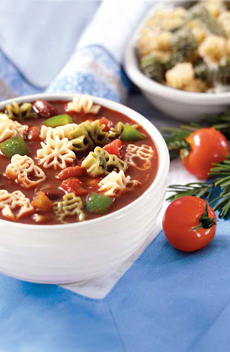 Novelty pasta shapes can spruce up any lunch or dinner. See our review of Pasta Shoppe, a NIBBLE Top Pick Of The Week.
Novelty pasta shapes can spruce up any lunch or dinner. See our review of Pasta Shoppe, a NIBBLE Top Pick Of The Week.
Last Updated March 2025
|
 |
Pasta Glossary
Page 5: Pasta Types With M, N & O
If you enjoy this Pasta Glossary, we have a food glossary for almost every category of food, including Italian favorites like cheese, espresso, and olive oil. Plus, find reviews of our favorite brands of pasta and sauces, pasta recipes, and informative articles about pasta in our Pasta Section.
Click on a letter to go to the appropriate glossary section.
a b c d e f g h i j k l m n o p q r s t u v w x y z
This glossary is protected by copyright and cannot be reproduced in whole or part.
You are welcome to link to it.
MACARONI or MACCHERONI
Macaroni is semolina-and-water pasta made without eggs (see FDA definition of macaroni products below). Many kinds of macaroni are tube-shaped, but there are other forms including shells, twists, and ribbons. Among the best-known tube shapes are: elbow (a short, curved tube), ditalini (tiny, very short tubes), mostaccioli (large, 2-inch-long tubes cut on the diagonal, with a ridged or plain surface), penne (large, straight tubes cut on the diagonal), rigatoni (short, grooved tubes) and ziti (long, thin tubes). Most macaroni almost doubles in size during cooking. The Italian spelling of the word is maccheroni. In the U.S., the word macaroni is usually synonymous with elbow macaroni. In Italy, however, the word “maccheroni” is a generic term for different types of short, hollow pasta tubes, many of which have other more specific names.
|
MACARONI and YANKEE DOODLE
A secondary meaning for the word macaroni or maccheroni is a well-traveled young Englishman of the 18th and 19th centuries, who affected foreign customs and manners, i.e., a fop or dandy. In those times, it was typical for a young man to go on a “grand tour” of the Continent to finish his education, prior to settling down. Many young Brits came back enamored of Italy, speaking particularly of the macaroni in Italy—hence the word association. In the mid-eighteenth century, “macaroni” described an overblown hairstyle as well as the dandy wearing it. Later in the century, the popular song, Yankee Doodle Dandy, was written and sung by the British in derision of the American colonists, who adopted it in self-defense. The song is believed to have its origins in the French and Indian War (1756–1763).
|
|
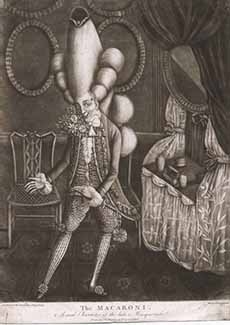
This 1773 mezzotint by engraver and political cartoonist Philip Dawe, is from a Wikipedia article on Yankee Doodle. It’s titled “The Macaroni. A real Character at the late Masquerade.” |
In contrast to the spit and polish of the British army, the colonials were a motley crew, some wearing buckskins and furs. Dr. Richard Schuckburg, a British Army surgeon reportedly wrote the tune. The colonials kept adding verses to it: Some 190 have been counted. “He stuck a feather in his cap and called it macaroni” means that the man who came to town for a good time, riding on a little pony—not a horse—thought himself a stylish dandy, although the song ridicules this feather-sporting pony-rider for thinking himself so when he was instead quite a sight to behold. “Doodle” comes from a German word meaning “simpleton.”
MACARONI VS. PASTA: THE DIFFERENCE DIFFERENCE
The basic components in the preparation of standard pasta and macaroni are the same: wheat flour, water, and salt. Pasta is made in many shapes, from long ribbons to fancy shapes like wagon wheels and bowties. Macaroni is a subset of pasta and comprises a group of hollow tubes, from small curved elbows to large straight cannelloni, which are stuffed and baked. Tubes and other shapes are extruded through metal dies. Another difference: The preparation of some pasta sometimes involves the addition of eggs, but macaroni does not involve eggs. The term “noodles” in the U.S. typically refers to egg noodles, which are popular in German and other cuisines.
MACARONI PRODUCTS
As classified by the FDA, these are the class of food, including spaghetti and vermicelli, which is prepared by drying formed units of dough made from semolina, durum flour, farina, flour or any combination of two or more of these, with water and with or without one or more optional ingredients specified. See also noodle products.
MACCHERONI
The Italian spelling of macaroni.
|
MAFALDINE
Also called mafalda, reginette (“queens”), and “the princess noodle,” because it was named after Princess Mafalda of Savoy. It was originally a Naples-regional shape called fettuccelle ricce (curly ribbons), but the name was changed in honor of the princess’s birth in 1902. Think of mafaldine as fettuccine with ruffled edges. The ruffles catch sauce in their curves.
|
|
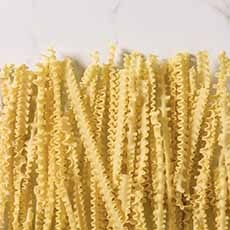
These organic, non-GMO mafaldine are available from Buona Furtuna.
|
|
MALFATTI
Malfatti is the regional term for gnudi in Lombardy, with gnudi being the term used in Tuscany. They're both typically served with sage butter or a light tomato sauce. Gnudi means “naked,” referring to the fact that this is a ravioli filling without the pasta wrapper. This makes them dumplings rather than pasta. Both are made with ricotta cheese, spinach, eggs, and Parmesan, then rolled in flour and boiled. Gnudi typically contain more ricotta and less flour. Both were originally created as a way to use leftover ingredients from ravioli filling, eliminating the need for pasta dough.
The name malfatti means ”badly made” or “misshapen,” referring to a rustic, irregular shape (although the ones in the photo look perfectly round).
|
|
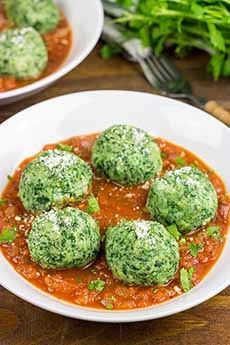
Here’s the recipe for these malfatti (photo © Spiced Blog). |
|
MACCHERONI AL TORCHIO
A torchio is a press, and these strips of pasta are pressed into attractive curls. A popular preparation is to serve them with “con pomodoro e rucola,” tomato and arugula. Make the sauce by combining 4 cloves of garlic, 1/4 cup extra virgin olive oil, 7 ounces of diced tomatoes (preferably San Marzano tomatoes), and 7 ounces of arugula in a sauté pan. Cook slowly, mashing the ingredients together with a fork. The maccheroni al torchio shown at left are made by artisan pasta maker Rustichella d’Abruzzo, and can be purchased from SalumeriaItalia.com.
|
|
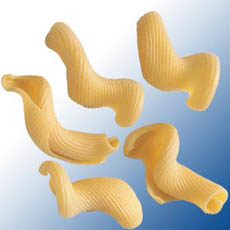
Maccheroni al torchio. Photo courtesy Pastazanini.it. |
|
MALLOREDDUS
These are half-inch-long ridged Sardinian pastas that look like small worms. They also are known on the island of Sardinia as gnochetti sardi or gnocchi, though they are nothing like actual gnocchi (see gnocchi description). This cut is absolutely delicious, in part due to the wonderful chewy texture of the tightly-rolled shape, and in part due to the aesthetic of the beautiful rolled and ridged appearance. You can purchase it on Amazon.com.
|
|
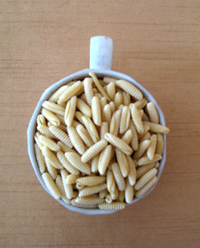
Malloreddus pasta looks like small worms. The kids should love them! Photo by Brian Van Sise | THE NIBBLE. |
|
MANICOTTI
A stuffed, baked pasta manicotti (mah-nih-CUT-tee) means “muffs” or “sleeves” in Italian. The large, tube-shaped noodles are about four inches long, and one inch in diameter. One of the oldest forms of pasta, in ancient times the dough was cut into large rectangles, filled with flavorful stuffings, then rolled and baked in the oven (what today is known as cannelloni). Today, pre-shaped tubes are boiled, then stuffed with a meat, cheese, or seafood mixture, covered with a sauce, and baked.
MARITATI
A mixture of two pasta shapes, orecchiette, ear-shaped pasta, and cavaturi, a short rolled pasta (mah-rih-TAH-tee). See also orecchiette maritate.
|
|
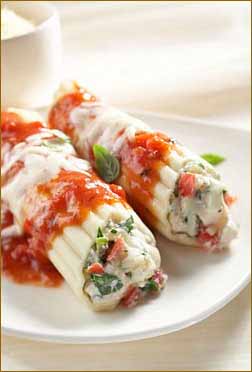
Manicotti, a popular stuffed tube pasta. Photo courtesy DairyMax. |
|
MARINETTI SAUCE
In 1932, Italian culinary magazine La Cucina Italiana awarded their Best Pasta Sauce prize to one chef’s Sugo Marinetti, or Marinetti sauce. The sauce stood out for its unconventional combination of tomato, anchovies, artichokes, ham, and chopped pistachios sautéed in butter. Its name is ironic, “honoring” the firebrand poet Filippo Marinetti, who disliked pasta and was at that very moment fighting to banish pasta from Italy. (You can’t make this stuff up!)
The sauce was created by Chef Amedeo Pettini, a former royal chef—and his [what was then] bizarre combination of ingredients was the winner. Here’s the recipe.
In his 1932 futurist cookbook “La Cucina Futurista,” Marinetti proposed avant-garde, highly experimental dishes meant to align with Futurist principles—speed, technology, and innovation. Some of these dishes included:
- Aerofood, a sensory experience that mixes textures and aromas, meant to be eaten while listening to music.
- Alaskan Salmon in the Sun, a fish dish with complex seasonings and presentations.
- Tactile meals, where diners were encouraged to touch different textured foods before eating.
|
|
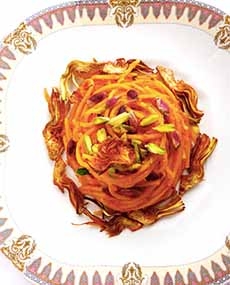
Linguine in marinetti sauce (photo © Samanta Cornaviera).
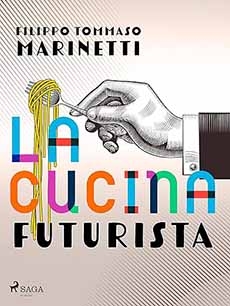
The book is available on Amazon.
|
Thus, if Marinetti himself had created a “Marinetti sauce,” it would have defied traditional recipes with unusual ingredients, bold flavors, and an experimental presentation.
|
MEZZALUNE or MEZZELUNE
The single form of the word is mezzaluna; the word means, literally, “half moon.” Mezzalune are crescent-shaped stuffed pasta. This shape of pillow pasta tends to be small. Typically, mezzaluna pasta uses egg pasta, which is rolled out and then cut with a small die into circular shapes. Any filling can be used. A dab of filling is placed on each circle and the circles are folded over and crimped to seal. The maker must ensure that it is not overloaded.
The word mezzaluna also refers to a hand-chopping tool, with the blades in the shape of a half moon.
|
|
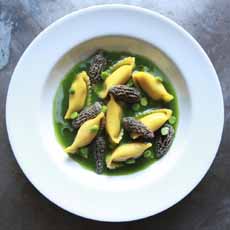
Cheese-stuffed mezzalune with morel mushrooms in a sauce and garnish of fresh green peas. Photo courtesy The Pines | NYC. |
|
MEZZI RIGATONI
Literally, “half rigatoni,” a shorter version of rigatoni, this cut is a versatile pasta shape, combining the heartiness of traditional rigatoni with a fun, smaller size (see photo at right).
MEZZI TUBETTI
Small, short-tubed pasta, generally used in soups. Also see ditali and ditalini.
|
|
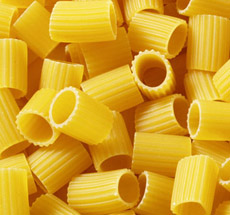
Mezzi rigatoni: half the length. Photo courtesy Barilla.us. |
|
MOSTACCIOLI
Mostaccioli (must-a-CHO-lee), literally “small moustaches,” are a specialty of the Campania region of southern Italy, which includes the cities of Capri, Naples and Sorrento. Large, 2-inch-long tubular pasta, they are cut on the diagonal (slanted or angled ends), with a plain surface, similar to regular penne. Both are designed for chunky tomato, meat and cream sauces.
NAKED GNOCCHI
See gnudi.
|
|
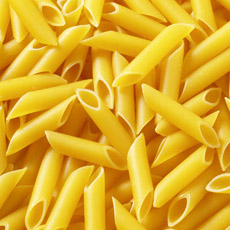
Mostaccioli, small moustaches. Photo courtesy Barilla.us. |
|
NOODLES
From the German word “nudel” meaning paste with egg. In America, the term refers to egg noodles as well as Asian forms of pasta. Noodles can be made of wheat, rice, soybean, potato, or other flours like oat; sweet potato or arrowroot starch; bean curd skin and tofu; and mung bean threads. Italian pasta (the word means “paste,” referring to the paste of flour and water from which it is made) is always made from durum wheat flour. Dumplings, including Polish pierogi and Italian gnocchi, and German spaetzle, are also considered forms of pasta.
|
|
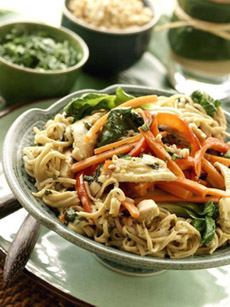
Mostaccioli, small moustaches. Photo courtesy Barilla.us. |
NOODLE PRODUCTS
According to the FDA, noodles are the class of food that is prepared by drying formed units of dough made with semolina, durum flour, farina flour (or any combination of two or more of these) with liquid eggs, frozen eggs, dried eggs, egg yolks, frozen yolks, dried yolks (or any combination of two or more of these), with or without water and with or without one or more of the optional ingredients specified. By law, egg noodle products must contain 5.5% egg solids by weight.
NOVELTY PASTA
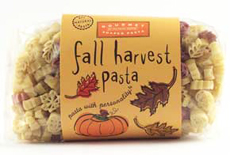 Pasta made in shapes reflecting everyday items, cultural icons, logos, etc. Shapes are available that celebrate seasons (leaves, sun, pumpkins), holidays (Santa, ghosts, hearts), hobbies (pets, sports equipment), flora and fauna. For inspiration, read our review of Pasta Shoppe novelty pastas (shown in the photo at left and at the top of the page). Pasta made in shapes reflecting everyday items, cultural icons, logos, etc. Shapes are available that celebrate seasons (leaves, sun, pumpkins), holidays (Santa, ghosts, hearts), hobbies (pets, sports equipment), flora and fauna. For inspiration, read our review of Pasta Shoppe novelty pastas (shown in the photo at left and at the top of the page).
|
OCCHI DI LUPO
Literally, “eyes of the wolf,” large, square-cut penne-like pasta (OH-key dee LOO-poe). Generally, this cut is paired with tomato or cream sauce.
ORECCHIETTE
Literally “little ears,” the Italian, word for ear is orecchio. Orecchiette are one of the three traditional cuts from the Puglia region (along with cavatelli and cavaturi). Orecchiette (oh-reh-KYEH-tay) work well with chunky meat and vegetable sauces.
|
|
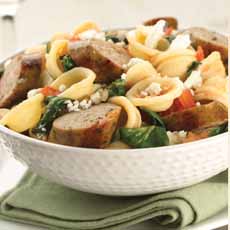
Orecchiette, ear-shaped pasta, combined above with sausage chunks. Photo courtesy Alfresco Pasta. |
ORECCHIETTE MARITATE
Literally “married” orecchiette, a Pugliese blend of the round orecchiette and the long, thin casarecci, which consummate their “marriage” in the pot when cooked together.
ORZO
Orzo, the Italian word for barley, is a small, 1/3-inch-long pasta shaped like a grain of barley or rice; it is made from semolina. In addition to plain semolina orzo, varieties are available flavored with black bean, red chile, and sweet potato, among other varieties. Orzo is frequently used as a substitute for rice and can be combined with rice to make pilafs. It is a versatile ingredient and can be used like rice or barley in soups, salads, sides, etc.
|
|
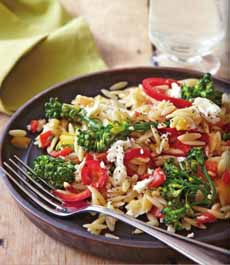
Orzo, rice-shaped pasta, here with broccolini and red bell peppers. Photo courtesy Melissa’s. |
Continue To The Next Page: Terms With P & Q
Go To The Glossary Alphabet Index, Above
© 2005-

|

















 Pasta made in shapes reflecting everyday items, cultural icons, logos, etc. Shapes are available that celebrate seasons (leaves, sun, pumpkins), holidays (Santa, ghosts, hearts), hobbies (pets, sports equipment), flora and fauna. For inspiration, read our review of Pasta Shoppe
Pasta made in shapes reflecting everyday items, cultural icons, logos, etc. Shapes are available that celebrate seasons (leaves, sun, pumpkins), holidays (Santa, ghosts, hearts), hobbies (pets, sports equipment), flora and fauna. For inspiration, read our review of Pasta Shoppe 
